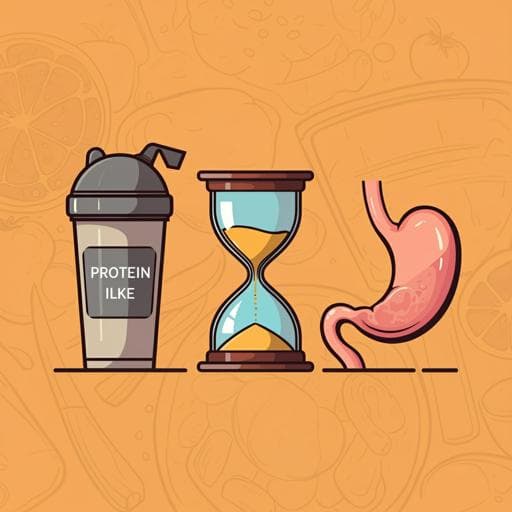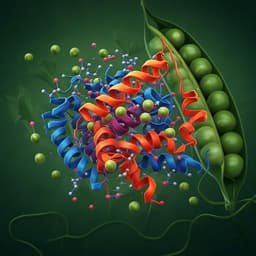
Health and Fitness
Acute effects of whey protein on energy intake, appetite and gastric emptying in younger and older, obese men
A. Oberoi, C. Giezenaar, et al.
Discover how obesity impacts the effectiveness of whey protein on energy intake and gastric emptying in older adults, an intriguing study conducted by Avneet Oberoi and colleagues. Uncover whether age blunts the benefits of dietary protein in managing obesity.
~3 min • Beginner • English
Introduction
The study addresses whether a 30 g oral whey protein load suppresses subsequent energy intake and alters gastric emptying and glycaemia in obese younger and older men. While obesity is prevalent across ages and associated with adverse outcomes in older adults, aging also alters appetite regulation, gut function, and body composition, with risks of sarcopenia exacerbated by inadequate protein intake. Protein is generally considered more satiating than other macronutrients and whey has anabolic advantages in older adults. Prior work showed whey suppressed energy intake in young non-obese but not older non-obese men, with differential effects potentially linked to gastric emptying and small intestinal feedback. It remains unclear if obese older adults exhibit similar responses, which has implications for using whey protein to manage weight and preserve muscle in aging.
Literature Review
Evidence indicates protein acutely suppresses appetite and ad libitum energy intake in young, non-obese adults and is often used in weight-loss diets. Whey protein, rich in essential amino acids, effectively stimulates muscle protein accretion in older men compared to casein. Gastric emptying tends to be modestly slower with age; obesity has minor, inconsistent effects. Prior studies from the authors showed lesser suppression of energy intake by orally ingested or intraduodenal whey in healthy older vs younger non-obese men. Food form influences satiety, with liquids being less satiating than solids. Mixed macronutrient and higher-energy preloads may yield different effects compared with lower-energy, pure whey drinks. These contexts frame expectations that protein’s satiating effects may be reduced in obesity and older age, and that gastric emptying and timing of subsequent meals may mediate responses.
Methodology
Design: Randomized, double-blind, cross-over trial with two study days per participant, separated by ≥3 days. Treatments: 30 g whey protein drink (120 kcal) vs control (~2 kcal), order randomized (balanced permutations), with both investigators and subjects blinded.
Participants: 20 obese men: younger (n=10; mean ± SEM age 27 ± 2 y; body weight 112 ± 8 kg; height 1.75 ± 2.81 m; BMI 36 ± 2 kg/m²) and older (n=10; age 72 ± 1 y; body weight 103 ± 4 kg; height 1.76 ± 2.56 m; BMI 33 ± 1 kg/m²). Groups did not differ significantly in body weight or BMI. Exclusion: smoking, alcohol abuse, diabetes (HbA1c > 6%), significant GI surgery, GI symptoms, medications affecting appetite/gastrointestinal motility, and in older: impaired cognition (MMSE <25) or depression (GDS ≥11). Ethics approval obtained; ANZCTR12616001216404; written informed consent provided.
Pre-study standardization: Standardized evening meal (~591 kcal beef lasagne) at ~1900 h before each study day; overnight fast (~12 h), avoiding strenuous activity.
Interventions: Drinks ~450 mL served in covered cup. Whey drink: 30 g whey (Bulk Nutrients) in 335 mL demineralized water + 85 mL diet lime cordial (2.5 kcal/100 mL); control: 360 mL water + 90 mL cordial; NaCl added (0.3 g whey drink; 1.2 g control) to match osmolarity (88 mOsm/L); volumes differed slightly (protein 439 mL; control 450 mL). Continuous stirring ensured mixing. Consumption within 2 min.
Procedures and measurements: Participants seated with IV cannula. Measurements at baseline (0 min), immediately post-drink (5 min), then every 15 min to 180 min. At 180 min, ad libitum cold buffet meal (total available energy 2,457 kcal; 19% protein, 50% carbohydrate, 31% fat) offered for up to 30 min (180–210 min), instructed to eat until comfortably full.
- Energy intake: Buffet components weighed before/after; energy and macronutrient intakes calculated (Foodworks v3.01). Cumulative energy intake included preload + buffet. Suppression calculated as % of control-day buffet intake.
- Gastric emptying: 2D ultrasonography (Logiq, GE Healthcare; 3.5C 2.5–4 MHz transducer) assessed antral area with superior mesenteric vein and aorta as landmarks; measurements at end-inspiration. Fasting antral area subtracted from post-drink values to derive gastric retention (%): Retention = [AA(t) − AA(f)]/[AA(max) − AA(f)] × 100. T50 (min) defined as time to 50% reduction from maximum post-drink antral area. Linear interpolation used when images lacked clarity. One older participant’s GE data excluded for insufficient image quality on both days.
- Appetite and GI symptoms: VAS (100 mm) ratings for hunger, desire to eat, prospective consumption, fullness, nausea, bloating at 0, 5, 15, 30, 45, 60, 75, 90, 105, 120, 135, 150, 165, 180, 210 min; AUC (0–180 min) by trapezoidal rule.
- Blood glucose: Capillary glucose (mmol/L) via glucose oxidase method (Optium Xceed); AUC 0–180 min by trapezoidal rule.
Statistical analysis: SPSS v25. Mixed-effects models assessed main effects of age and treatment and their interaction; unstructured covariance for repeated measures by subject. Between-age comparisons (suppression of energy intake by protein; control condition outcomes) via paired t-tests. Significance P<0.05. Data as mean ± SEM.
Key Findings
- Energy intake: Older men consumed ~20% less than younger men after drinks, not statistically significant (age effect P=0.16). Whey protein did not suppress subsequent ad libitum buffet energy intake vs control in either group: younger control 1173 ± 130 kcal vs protein 1114 ± 124 kcal; older control 926 ± 99 kcal vs protein 892 ± 127 kcal (protein effect P=0.46; age × protein interaction P=0.84). Percent suppression by protein: younger −3.0 ± 7.7%; older −2.3 ± 8.4% (P=0.95). Cumulative energy intake (preload + buffet): no effect of age (P=0.16), protein (P=0.25), or interaction (P=0.84).
- Gastric emptying: Protein drink emptied more slowly than control in both age groups. T50 (min): younger control 25 ± 5 vs protein 40 ± 7; older control 16 ± 5 vs protein 50 ± 8 (protein effect P=0.001; age effect P=0.93; interaction P=0.13). Baseline fasting antral areas did not differ by age or treatment; control GE did not differ between ages (P=0.21).
- Blood glucose: Older men had higher fasting glucose (older 6.1–6.2 mmol/L vs younger 5.4 mmol/L; age effect P=0.003) and higher AUC 0–180 min (younger control 1003 ± 17, protein 981 ± 21 mmol/L; older control 1112 ± 28, protein 1108 ± 37; age effect P=0.005). Protein had no effect on glucose (protein effect P=0.42; interaction P=0.54).
- Appetite and GI symptoms (AUC 0–180 min): No significant main effects of age or protein for desire to eat (P=0.07, P=0.71), hunger (P=0.07, P=0.35), fullness (P=1.0, P=0.57), prospective consumption (P=0.15, P=0.57), bloating (P=0.28, P=0.11). Nausea AUC higher in younger vs older (age effect P=0.04), no protein effect (P=0.74). Baseline VAS mostly similar across groups and treatments; specific interaction patterns observed for prospective consumption and desire to eat at baseline but without consistent treatment effects over time.
Discussion
The primary aim was to test whether a 30 g whey protein drink suppresses energy intake in obese younger and older men. Contrary to findings in lean, non-obese young men (where 30 g whey reduced intake ~17% at 3 h), whey protein did not reduce ad libitum energy intake in obese men of either age, nor did it alter appetite ratings. Gastric emptying was slowed by whey in both age groups, yet this did not translate into reduced subsequent intake under the study conditions (with the buffet meal at 180 min, when gastric contents were largely emptied). These results suggest that obesity may blunt the satiating effects of whey protein similarly to physiological aging, diminishing protein-induced suppression of appetite and intake. Differences from studies showing suppression with mixed-macronutrient or solid preloads highlight the importance of preload composition and food form; liquids are often less satiating than solids of equivalent energy. Elevated glucose in older men was unaffected by protein, indicating glycaemia likely did not mediate intake differences. Overall, whey-induced slowing of gastric emptying appears insufficient to affect intake at the 3-hour mark in obese men, and obesity may dampen protein’s satiating signals.
Conclusion
A 30 g whey protein drink did not suppress appetite or ad libitum energy intake in obese younger or older men, despite slowing gastric emptying similarly across ages and without affecting glycaemia. These findings imply that obesity may attenuate the satiating effects of whey protein and mimic aging-related reductions in protein-induced appetite suppression. Practically, liquid whey protein supplementation is unlikely to aid weight loss in obese men of any age, but may be used in older adults to support muscle maintenance without risking appetite suppression. Future research should include larger samples, multiple protein doses, comparisons of liquid versus solid protein forms, earlier post-preload test-meal timings, use of gold-standard gastric emptying methods (e.g., scintigraphy), and inclusion of women to assess sex-specific responses.
Limitations
- Small sample size (n=10 per age group) limits power and generalizability.
- Single whey protein dose (30 g; 120 kcal); dose–response not assessed.
- Did not assess taste/pleasantness, which could influence intake.
- Gastric emptying measured indirectly via 2D ultrasound; 3D ultrasound or scintigraphy (gold standard) not used; ultrasound can be less reliable in obese individuals.
- Only men were studied; findings may not generalize to women.
- Test meal provided at 180 min; earlier timing might have revealed different satiety effects when gastric retention differences were greater.
Related Publications
Explore these studies to deepen your understanding of the subject.







